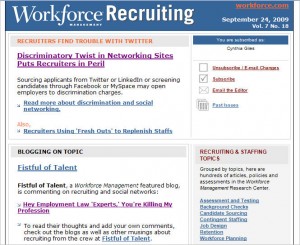Workforce Management has come up with another surprising article. (The first one was discussed here recently in Cut on the Bias.) And this time, the fur is flying.
The article is Discriminatory Twist in Networking Sites Puts Recruiters in Peril. If the title seems a bit melodramatic—it really doesn’t hold a candle to the contents. Highlights:
- “Sourcing from professional network sites such as LinkedIn carries a risk that the method could be challenged on discrimination grounds,” says Pamela Devata, a partner at Seyfarth Shaw in Chicago. “It represents a hiring pool that is not open to the general population.”
- “Networking sites, including Twitter, exclude whole populations,” says Jessica Roe, managing partner at Bernick, Lifson, Greenstein, Greene & Liszt in Minneapolis. “The social networks represent limited social groups and very small labor pools. It’s an enormous issue.”
- Paul Mollica, partner at Meites, Mulder, Mollica & Glink in Chicago, has another warning for heavy users of networking sites: “When the OFCCP [Office of Federal Contract Compliance Programs] or plaintiffs’ attorneys come along with a discovery request and want to see the trail for recruiting, these employers are going to come up short,” he contends, because “the records are in a digital mist.”
And it’s not over when the sourcing is done. In the selection phase, “using social networks to screen candidates generates additional legal risks,” according to the article. Explains Mollica,“the risk is that visiting Facebook or MySpace pages or even Googling candidates may reveal information that no employer should have in a properly constructed application or interview.”
There are even more perils to be feared, such as the dangers of changing job descriptions and laying off people who were “hired into bad positions.” But if you want to be thoroughly warned, read the whole article.
In the meantime, let’s take a look at the blowback. Commenters are mixed in their responses—but one of them (solubrious1) offers this heartfelt response: “Stop freaking out about pretend legal issues when the real issue is workforce design, the concept of ‘permanent’ work, and the decisions made by political and business leaders (many who also do not use Twitter and Facebook) to de-value Human Resources in the core mission and vision of their organization.”
Meanwhile, one of Workforce Management’s featured blogs (Fistful of Talent) takes aim at the “Discriminatory Twist” article and lets loose with a full-scale rant: Hey Employment Law “Experts”, You’re Killing My Profession . . .
Worth reading, including the comments. Choice quote: “Oh, I forgot. You only care about promoting your little section of the world, which is risk management from a legal perspective. In the meantime, you scare, intimidate and generally freeze the average HR person from adopting tools that can help them do their jobs better . . . “
What’s the relevance of all this for the corporate Careers site? I suspect that similar concerns come up in the context of using social media and blogs as part of employer branding and online recruiting. The problem is (for all concerned) that Genie has left the bottle, and won’t be going back in.
So the inevitable outcome is “a period of adjustment.” Those are never fun.
Lucy is Editor at Corporate Eye




I would think that the potential discrimination issues should be STRONGLY considered by recruiters and companies before they try to move to sourcing only via these methods. There will always be a need for postings or resume database mining to make sure you are finding the best possible candidates.
Hi, Chris–thanks for your comment. I think the key word in your statement is “only.” Although the article made some very generalized statements (to my mind, anyway), I think it was directed primarily toward over-reliance on social media recruiting–and that’s obviously bad strategy from a sourcing standpoint, with or without legal implications. But there are still some interesting questions raised, and as you suggest, this topic should be taken seriously. One point of the Workforce article was that litigation lags far behind actual events, so it’s not yet clear what types of complaints may be coming along. A wide assortment of practices that rely on technology could yet be called into question. On a practical level, it seems like common sense and integrity continue to be the “best practices.”
Simple fix for the “Legal Risk-Mongers”… Add Using social media networks effectively as a selection criteria, right along side with “Staying current in industry trends that affect the area of x”. It’s one in the same.
This “exclusion” of an entire candidate pool is actually a valuable selection criteria.
Hi, Marc–thanks for your comment. I had a similar thought when first reading the article; then I got to the part about the risks of “upgrading” job requirements to add any criteria that cannot be obviously and directly related to performance in a specific job. (My paraphrase.) As a general example–I’m guessing a requirement related to social media might be considered reasonable for a marketing position, but not for a job in accounting. So for now, recruiters may have to negotiate carefully between existing employment law and emerging realities.